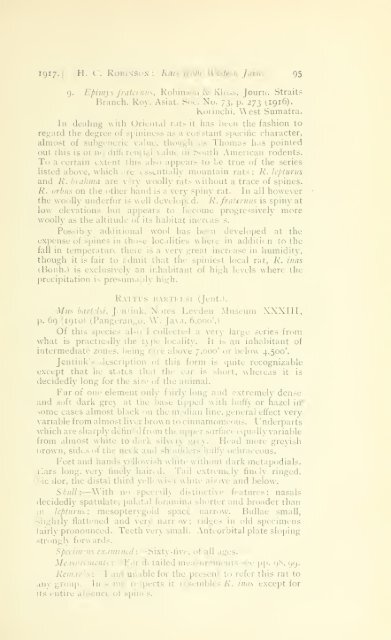Journal of the Federated Malay States museums - Sabrizain.org
Journal of the Federated Malay States museums - Sabrizain.org
Journal of the Federated Malay States museums - Sabrizain.org
Create successful ePaper yourself
Turn your PDF publications into a flip-book with our unique Google optimized e-Paper software.
1917O H. C. Robinson: Rats from Western Java. 95<br />
9. Epimys fraternus, Robinson & Kloss, Journ. Straits<br />
Soc. No. 73, p. 27j (1916).<br />
Korinchi, West Sumatra.<br />
.<br />
In dealing with Oriental rats it has been <strong>the</strong> fashion to<br />
regard thi ml specific character,<br />
almost ol though as Thomas has pointed<br />
out this is /alue in South American 1<br />
1 be<br />
true <strong>of</strong> <strong>the</strong> series<br />
listed above, which are essentially mountain rats: R. Upturns<br />
and R.brahma are ver) W00II5 rats without a trace <strong>of</strong> spines.<br />
j spiny rat. In all however<br />
lly underfur is well devi loped. R. fraternus is spiny at<br />
low elf vatioi progressively more<br />
woolly as <strong>the</strong> altitude <strong>of</strong> its habit: ;<br />
bly additional wool ha loped at <strong>the</strong><br />
expense <strong>of</strong> spines in those localities where in addition to <strong>the</strong><br />
fall in temperature <strong>the</strong>re is a verj - in humidity.<br />
though 11 is fail to admit that <strong>the</strong> spiniest local rat, R. inas<br />
is exclusively an inhabitant <strong>of</strong> high levels where <strong>the</strong><br />
precipitation is presumably high.<br />
Ratti (Jent.).<br />
um XXXIII,<br />
1<br />
[>. 69 (1910) (Pangerango, W. Java, 6,000'.)<br />
Of th from<br />
what is lity. It is an inhabitant <strong>of</strong><br />
intermedi re above 7.000' or below 4.500'.<br />
Jentink's description <strong>of</strong> this form is quite<br />
except that he states that <strong>the</strong> ear is short, whereas it is<br />
decidedly long for <strong>the</strong> size <strong>of</strong> <strong>the</strong> animal.<br />
Fur <strong>of</strong> one element only fairly long and exti<br />
and s<strong>of</strong>t dark grey at <strong>the</strong> base tipped with buffy or hazel in<br />
ffect very<br />
from almost liver brow n tocinnamomeous. Underparts<br />
which are sharply defined from <strong>the</strong> upper surface equally variable<br />
1 from almost white 10 dark silvery grey.<br />
brown, sides <strong>of</strong> <strong>the</strong> n<br />
Head more gn h<br />
Feetand hands yellowish white without dark metap<br />
Ears Ion n finely ringed.<br />
bicolor, <strong>the</strong> distal third yellowish white above and below.<br />
Skull:— Witl features; nasals<br />
decidedly spatulate, palatal f< rter and broader than<br />
in Upturns; mesopterygoid space narrow. Bullae small,<br />
slightly flattened and verj narrow; ridges in old spi<br />
fairly pronounced. Teeth very small. Anteorbital (date sloping<br />
: Specimens examined — Sixty-five, <strong>of</strong> all i<br />
Me:-<br />
Remarks:— I am unable for <strong>the</strong> present to rel<br />
its iiit 1 1 - spines.<br />
ts ci ept foi
















